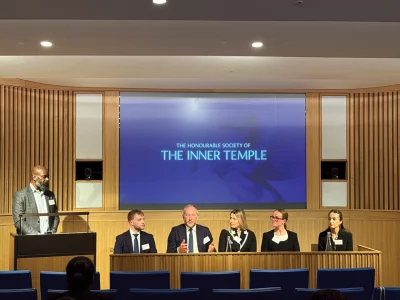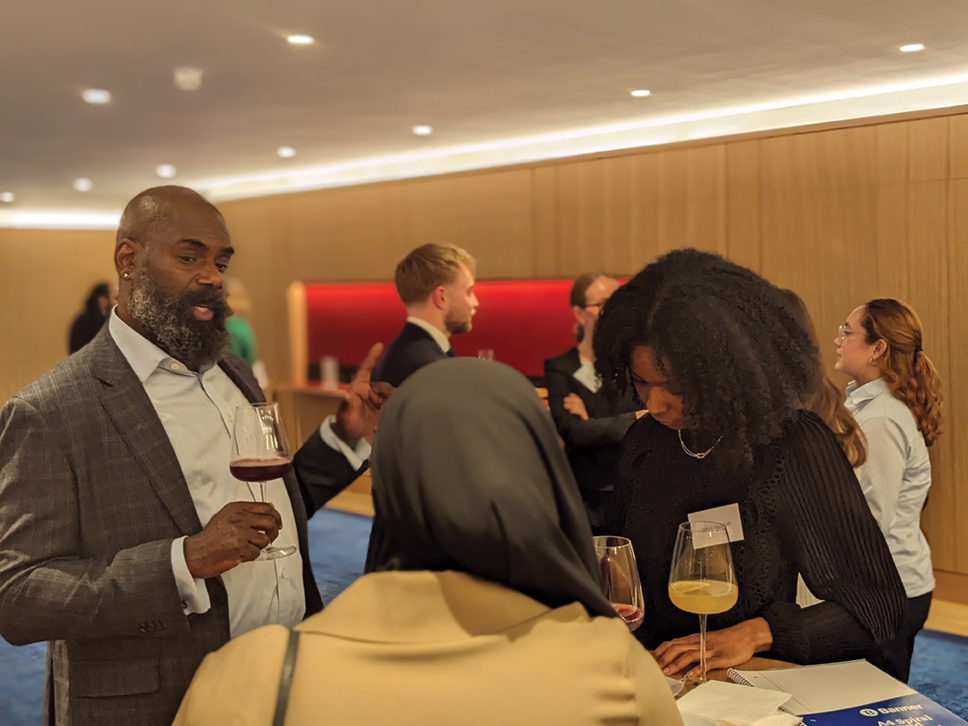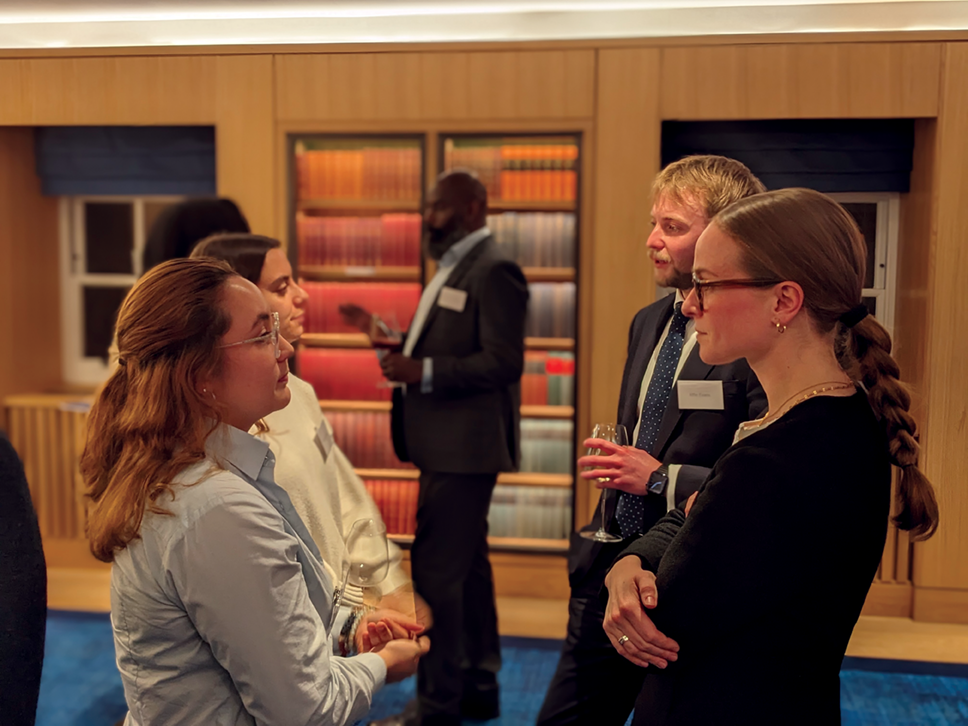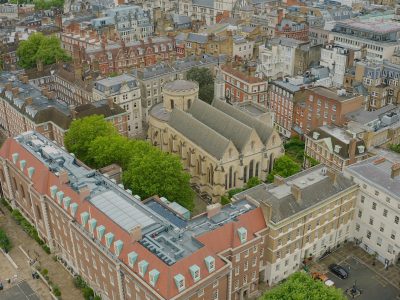

Employed Pupillages
On 25 March 2025, Carlé Philbin, Daisy Caldwell, Alfie Evans, Commodore James Farrant RN and Rebecca Paterson shared their experiences of employed pupillages. They offered insights and tips about the application process and the pros and cons of being employed. Introduced by the Chair of the Employed Bar Forum, Master Sara Lawson, the session was chaired by Master Simon Regis.
Alfie Evans: I’m a barrister at the Government Legal Department, currently at the Attorney General’s office, and I qualified last September. After studying law at the University of Bristol and obtaining a scholarship from The Inner Temple, I was called to the Bar in 2021. I didn’t immediately get a pupillage straight off the back of the Bar Course, so I worked as a paralegal in the insolvency service.
While there, and somewhat randomly, I came across the Government Legal Department (GLD) pupillage, not having known much about the GLD, or been particularly interested in public law at university. I successfully applied and started pupillage in 2023, working as a paralegal for the Department of Transport in the interim. My first seat, or six as it would be in the self-employed Bar, was in immigration litigation, where I managed a caseload of judicial reviews against the Home Office in respect of asylum claims and decisions.
My second seat was spent on secondment to 39 Essex Chambers. My work there was quite varied, but it generally had a public theme. My supervisors did a lot of immigration work, environmental work, procurement, and planning.
I qualified in September last year, but the GLD training scheme is two years’ long, so although you qualify after one year, you then have another year where you do two six month stints of advisory work, such as advising on government policy, having the opportunity to draft secondary legislation and working with the Office of Parliamentary Council on primary legislation. My advisory year was split between two different departments; the first was at the Department for Environment, Food and Rural Affairs (DEFRA), where I worked on animal diseases, trade, and the water industry.
I’m now at my fourth and final seat, at the Attorney General’s office, where I advise and brief the Attorney General and Solicitor General on bills and policies across Whitehall.
The first seat will always be doing immigration, and the second seat will always be on secondment – secondment is broadly similar to what the first six would be like in a self-employed pupillage. That could be drafting skeleton arguments or drafting grants of appeal. The only exception is that you only take instructions from the GLD, and you only do those in respect of immigration matters in the other tribunal – known as oral commission hearings.
There are five stages to the application to the GLD: a situational judgment test; verbal reasoning tests; and a critical reasoning test. All three tests are multiple choice. I recommend doing the gov.uk practice tests. The fourth stage is a video interview that’s pre-recorded, so the questions flash up on screen and you’re given a set amount of time to answer them – in my opinion they’re probably the hardest part of the process. The fifth stage is the assessment centre, which is split between two core parts. The first part is a written exercise to analyse a practical legal issue. It’s not a test of legal knowledge as you’re given all the law in advance, it’s more to see how well you can analyse the issue, especially within the context of policy and politics.
The second part of the assessment centre is an in-person interview. You’re asked questions about your response to the written exercise to hear why you responded the way you did. The second set of questions is the largest part of the interview. These are behaviour-based questions to assess how you’ve handled past situations against defined behaviours listed in the person specification, such as delivering at pace, making effective decisions, communicating and influencing.
My biggest tip for preparing for these interviews is to focus on the behaviour-based questions. You should always follow the STAR method when you’re responding, (Situation, Task, Action, Results). The third type of question you’re asked is strength-based to assess what you enjoy and what motivates you. The fourth type of question is motivational such as “Why the public sector? Why the public Bar?”
Some of the most enjoyable work that I’ve done during my pupillage was drafting my first Statutory Instrument at DEFRA – a personal proud moment.
Another was drafting detailed grounds of resistance for the government’s defence in the Court of Appeal case, Save Stonehenge World Heritage Site Ltd v Secretary of State for Transport 2024 EWCA Civ 1227, which was in relation to the proposed tunnel that would be going under Stonehenge, and preparing speaking notes for my supervisor in the Court of Appeal.
While at DEFRA, I worked with senior policy officials and the Chief Veterinary Officer to respond to an outbreak of foot and mouth disease in Germany and drafted measures which prohibited the import of certain goods from entering the UK from Germany. For obvious reasons, I can’t talk about the work I do in the Attorney General’s Office but, take my word for it, it has been really interesting.

Commodore James Farrant RN: I’ve been in the Royal Navy for 26 years. All three of the armed forces have lawyers in uniform dealing in three areas: crime and discipline, employment (or terms and conditions, and terms of engagement), and operational law, which is probably the one that varies the most between the three services.
As a naval lawyer I’ve spent a lot of time advising on the law of the sea, the law of maritime operations, law of naval warfare, weapons law, both in terms of advising on principles, but also engaging with the academics whose work is based on those issues.
Aspects of operational law – employment, crime and discipline – are similar across all three Services. However, the operational legal advice, is where it differs the most between the army, the navy, and the air force. Obviously, I’ve spent a lot of time advising on the law of the sea but, if you’re an army lawyer, you advise on land-based operations, including detention-type operations, for example, when you can detain an individual, for what reasons, and in what conditions. Whereas, if you’re in the air force, you’ll spend a lot more time advising on kinetic targeting operations, such as strike operations from bomber and fighter aircraft.
There are two routes to joining the army: the first is to qualify as a barrister or a solicitor and then apply to join the army (ditto with the RAF); the alternative route is via pupillages. For the first time, in the last year or so, the army is offering a small number of pupillages.
Once you’ve joined the army, they will find you a pupillage in a set of chambers. Once you’ve completed pupillage in chambers you then go back to the army as an army lawyer.
The Royal Air Force is not currently offering pupillages, but it is offering trainee solicitor placements. In the navy, the method is more complicated. You join the Royal Navy as something other than a lawyer, because the navy doesn’t have a legal branch at all. You must be good enough for them to invest in you, send you to Bar school, and pay you through pupillage. That is the only mechanism to become a lawyer in the navy.
We recruit all our lawyers internally, but we only recruit barristers, sending them to sets like Red Lion for pupillage, whereas the army and the air force recruit both solicitors and barristers. In terms of employed pupillages, you can certainly have one with the army but there aren’t very many of them. You can have one with the navy, but you have to do something else for a little while first, and, if you want to join the Royal Air Force, you either qualify as a barrister or apply to join in a trainee capacity as a trainee solicitor.

Carlé Philbin: I am an employed barrister at DAC Beachcroft based in Manchester, specialising in personal injury, so I’m in court nearly every day. When I’m not in court, I’ll be at home doing paperwork. Having just completed my pupillage in March 2024, I’m doing a lot of trials now.
Personal injury involves road traffic accidents (RTAs), employer’s liability, and public liability. The interesting part is the access DAC Beachcroft have to different types of work. Being such a large international law firm, they have many clients who instruct them. I’m now able to do fraud.
After completing the Bar Course, and unsuccessfully applying for pupillage, I turned to DAC Beachcroft to be an employed advocate. I hadn’t been there that long when I, and others, were encouraged to apply for the first pupillage they’d ever offered.
Pupillage was structured in a similar way to pupillage at the self-employed Bar, with a first and second six. In the first six, you’re following around various members in chambers, not limited to Manchester, so you have to travel quite far, which is definitely something to consider. The second six months is tailored more to you and hopefully based nearer to home which, for me is on the the Northern Circuit.
I had two pupil supervisors; one for personal injury work, and the other for property-based work, which enabled me to conclude that I do not want to go into property damage!
In pupillage, there are six pieces of assessed drafting work to do. You are given feedback on each piece of work that is marked each time so that you can improve your drafting. There are, of course, regular meetings to discuss that work.
DAC Beechcroft have plans to offer pupillage every year if you are interested in applying through that route. You have to get through the paper sift, which is assessed by various barristers. The second part is an advocacy-based task. I was given different statements from which to choose one to argue for or against in front of three barristers. After that, there’s a second round advocacy based interview. I had to do an application to set aside a default judgment. I also had to read a Court of Appeal judgment and answer questions about that.
The advantages of the employed Bar depend on what type of person you are. Many people like being employed. You’ll get paid the same amount every month, whereas some people at the self-employed Bar are often waiting to get their billed money.

Daisy Caldwell: I work for the Crown Prosecution Service (CPS) as a barrister; we’re called Crown Advocates. I finished my pupillage in September of last year, so I’m in my first six months on my feet as a Crown Advocate. My pupillage was not dissimilar to a self-employed pupillage as you have a pupil supervisor. I spent a lot of my time in both the Crown Court and the Magistrates’ Court shadowing and doing a lot of written work as well. Similar to Alfie’s experience, we have secondments to self-employed chambers.
I spent a couple of months over at Foundry Chambers, which was an excellent and really interesting experience – as well as being very useful to have a comparison about how things work at the self-employed Bar versus the employed Bar.
A big advantage of a CPS pupillage is also the ability to take on internal secondments. We have specialist teams in RASSO (rape and serious sexual offences); serious fraud; terrorism; and homicide that you can shadow with some ease. In terms of advantages of pupillage with the CPS, I’m sure many of you will be aware of the difficulties that face criminal barristers at the present time. Having been employed by the CPS, you do have a level of insulation from some of those issues.
Carlé has just referenced the pay, which is something that I know a lot of criminal barristers really struggle with, especially now assessing trial dates. I was at Snaresbrook Crown Court yesterday and set a trial date in 2029, so that barrister won’t get paid until that trial is finished. There’s also, of course, all of the amazing benefits that come with being employed: holiday, pension, sick pay. Now that I’m fully qualified, I’m on my feet in the Crown Court most days with a really varied practice.
Another huge benefit of being in-house is the range of training available to you; training put on internally at the CPS, but also mock trial training sessions with Red Lion, and we get paid to undergo the training offered at the Inns of Court. There are many resources available to you as well as a fantastic cohort of barristers who are always incredibly willing to lend a helping hand.
Another huge benefit of being in-house is the range of training available to you.
It’s amazing to have that cohort of people to share your pupillage with, without the fear of whether or not you’re going to get tenancy. At the CPS – if you progress – there’s no competitive application for tenancy at the end of the year, which is a huge advantage that really allows you to focus on your development during pupillage.
Some disadvantages: you are working for a large organisation that sometimes moves slowly, which I know a lot of people can find frustrating, and many of you may be considering life at the Bar because you are very driven, very motivated and interested in a fast-paced life.
Other than that, there aren’t too many disadvantages. Unlike Carlé and most self-employed barristers, I don’t have to travel around the country. I’m based in London, so I never have to travel outside of London. In terms of the application process, we are a government organisation, so applicants must make a civil service application, although slightly modified for barristers, and very similar to what Alfie has described.
At the CPS, you will be given really incredible work every day of the week and develop at your own pace, thanks to the large amounts of support and training offered.
Rebecca Paterson: I am a tenant at Pump Court Chambers. I did an employed pupillage at the Nursing and Midwifery Council (NMC), and then, after a period of practice as an employed barrister, I began a third six pupillage at Pump Court.
The NMC is a healthcare regulator for midwives and nurses. Some people think that the NMC’s regulatory proceedings are to do with clinical negligence. They’re not; the focus is on fitness to practice.
Of all the different applications I completed for pupillage, the NMC had the lengthiest process. There were very specific questions that asked about specific competencies. It was suggested that I answer those in a STAR format. I felt that really helped me think about all the skills that I had and how they could be transferable into such a niche area of practice. There was then a written assessment, followed by a two- or three-hour interview with an advocacy exercise. I had a couple of interviews in chambers which I found very intimidating. I felt a little bit like I was being cross-examined in my interviews. It was all good practice, but when I had my interview with the NMC, it was much more open and supportive.
The pupillage itself was fairly standard in that the first six months were shadowing fitness to practice proceedings and practising undertaking legal reviews of evidence.
I didn’t observe any other types of hearing during my first six. I did about two weeks with the General Counsel team, so I saw a little bit about policy and employment. At the time of my pupillage, NMC pupils no longer engaged in secondments to other organisations or chambers. In my second six, it was all about getting advocacy experience. I was presenting fitness to practice proceedings at hearings, starting with the one-day hearings through to eight-day hearings with multiple witnesses by the end of my pupillage.
There were a couple of things that I experienced as a pupil at the NMC that I don’t think that I would have experienced as a pupil at the self-employed Bar. One was getting to present in the High Court. At the NMC, they deal with interim injunction-type applications, and they’re done before a High Court judge, so I was regularly appearing before a High Court judge making those applications.
It can be quite scary at times, because you’re put against people of many years’ Call, often established in criminal practice. It taught me a lot in terms of witness handling, thinking on my feet, and not being intimidated by my opponent.
I have since left the employed Bar and started a third six at Pump Court in June last year. I realised that I wanted to expand my practice to include employment law. The role involved a lot of case management; dealing with early witness issues, encouraging them to come to a hearing, and deciding what goes in the bundle. These are all key parts of a case before it gets to the final hearing – all very useful but not necessarily my favourite part of the role, and not where my skills lie.
One of the best things about the employed Bar and why I’m so happy that I did do an employed pupillage, is the support. I felt that there were so many people who were willing to help me. I got 30 days of paid annual leave, which is just astounding to me now! I felt more like I was part of a team rather than a sole practitioner whilst at the employed Bar.
Alfie Evans
Called 2021, The Inner Temple
Cdre James Farrant RN
Called 2007, Gray’s Inn
Daisy Caldwell
Called 2022, Lincoln’s Inn
Carlé Philbin
Called 2021, The Inner Temple
Rebecca Paterson
Called 2021, Gray’s Inn
For the full video recording:
innertemple.org.uk/employedpupillages
